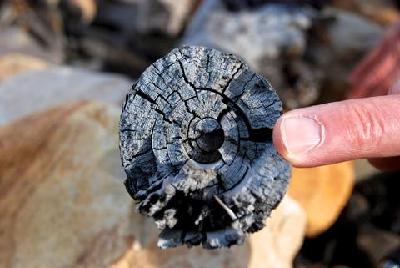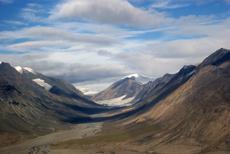
A discovery of a mummified forest that's between two and ten million years old is giving scientists a new window on climate change.
Joel Barker made the discovery by accident. The Ohio State University polar scientist was doing research on Ellesmere Island in the Canadian Arctic when his ranger pointed out a stick in the mud.
"And sure enough there was all this wood debris at the bottom of this valley," Barker says.
The site is one of about a dozen in the Canadian Arctic where warming temperatures and reduced snowfall have caused the glacial ice sheets to retreat and expose land where ancient forests once stood. Barker says what makes this particular forest site unique is that it was so far north.
"To find the source of where this stuff was coming from was pretty exciting. And then to sort of dig in the soil and find leaves, much like the leaves that you'd find in the Spring sort of emerging from a melting snow pack. They look sort of weathered, but you can pick them up and they are still leaves you are holding in your hands from a couple of million years ago."
Barker says these mummified trees - unlike petrified or fossilized wood - didn't decompose or turn to stone. He suspects they were buried suddenly by a massive landslide and entombed in the dry, airless soil. "So, you take away water. You take away oxygen. Things get preserved," he says.
The ancient forest debris looks much as nature left it. The birch, pine and spruce logs, branches and leaves from long ago are remarkably well-preserved, and it's easy to see that they don't match the hardy scrub growing in the Arctic today. The mummified woods more closely resemble the trees found in forests now hundreds of kilometers south.
Ocean sediment cores and the absence of the common redwood tree known to have grown in the region ten million years ago date the newly-found arctic forest to between two and ten million years. Research Joel Barker says the low species diversity is a sign of an ecosystem on the edge of extinction.

"This forest existed at a time when the Arctic was cooling and climate was deteriorating very quickly. And so I think this allows us, by looking at the mummified remains, to see how the ecosystem responded to the cooling, how rapidly the cooling occurred and to maybe identify any thresholds that were reached. And once we identify those thresholds, we can start making predictions about how quickly the ecosystem will respond to future warming."
The growth rings on some trees put their age at about 75 years old when they were suddenly buried. Their branches appear spindly, with very narrow rings, suggesting the trees were suffering a great deal of stress when they were alive. Barker, a research scientist with the Byrd Polar Research Center at the Ohio State University, plans to do further analysis with chemical and DNA testing. His preliminary findings were presented this week at the American Geophysical Union meeting in San Francisco.
birch: a tree with smooth bark and thin branches; It grows in northern countries. 桦树;白桦树
spruce: an evergreen forest tree with leaves like needles 云杉
spindly: very long and thin and not strong 长而纤弱的;细长而瘦弱的
Development agencies call for indigenous people to play role in forest management
Climate scientists too worried about bushfires
Tree deaths in Western US linked to climate change
(来源:VOA 编辑:崔旭燕)
